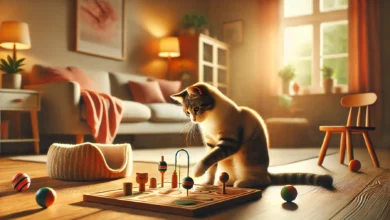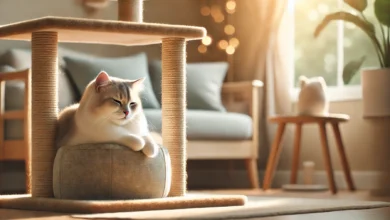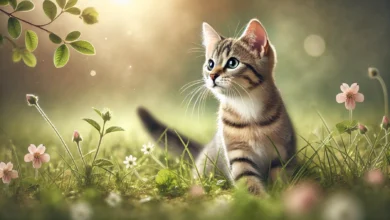How to Teach Cats to Avoid Eating Houseplants
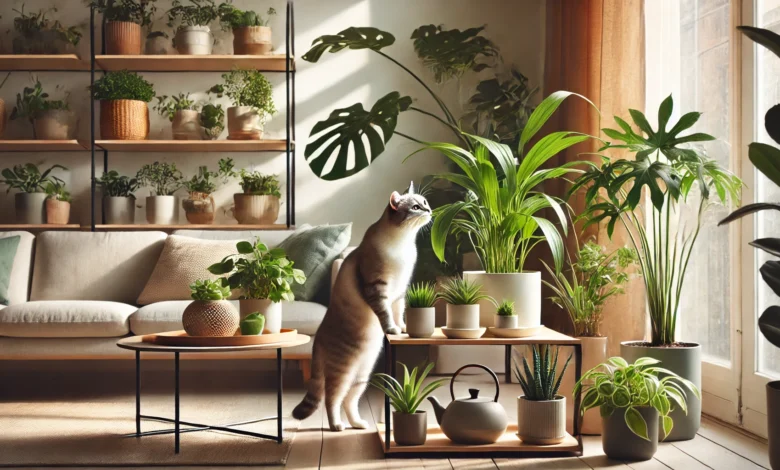
As a cat owner, you probably notice how your feline friend could get interested in your houseplants.
While this may seem like an innocent, curious act, it can sometimes become a problem if your feline starts nibbling on them.
Most cats are naturally fascinated with houseplants due to boredom, nutritional needs, or fascination with their feel and texture.
While some plants are toxic to them, you really should teach a cat to avoid eating houseplants.
In this article, we will go over why houseplants attract cats and suggest practical ways to stop the behavior, ensuring both your cat and houseplants remain safe.
Understanding why cats eat houseplants is the first step toward breaking the habit.
These reasons can vary, and some might even surprise you.
Let’s delve deeper to understand what makes your cat snack on your greenery.
Table of Contents
Why Cats Eat Houseplants: Understanding the Behavior
Understanding why your cat chews on plants is crucial in stopping this behavior.
Cats are complex creatures, and plant-eating can be motivated by various causes.
Identifying the root cause helps you better guide your cat in avoiding eating houseplants.
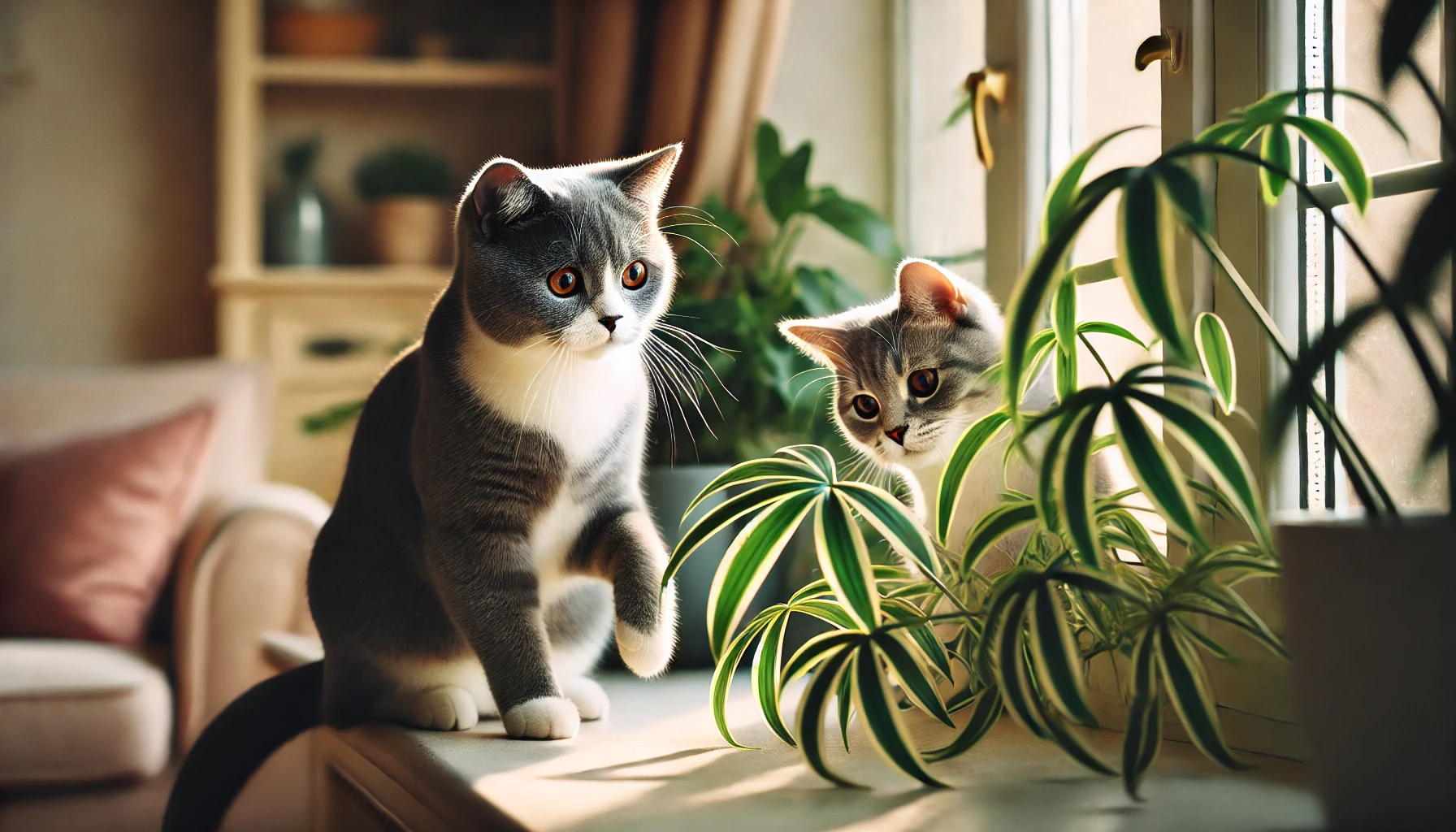
Curiosity and Instinct
Cats are naturally curious creatures.
When they encounter something new or unfamiliar, they may investigate it with their paws, noses, and sometimes their mouths.
Houseplants can easily pique a cat’s curiosity due to their shapes, textures, and smells.
Outdoor cats tend to graze on grasses and other vegetation.
This natural behavior may continue indoors when they encounter houseplants, enticing them to nibble on the leaves.
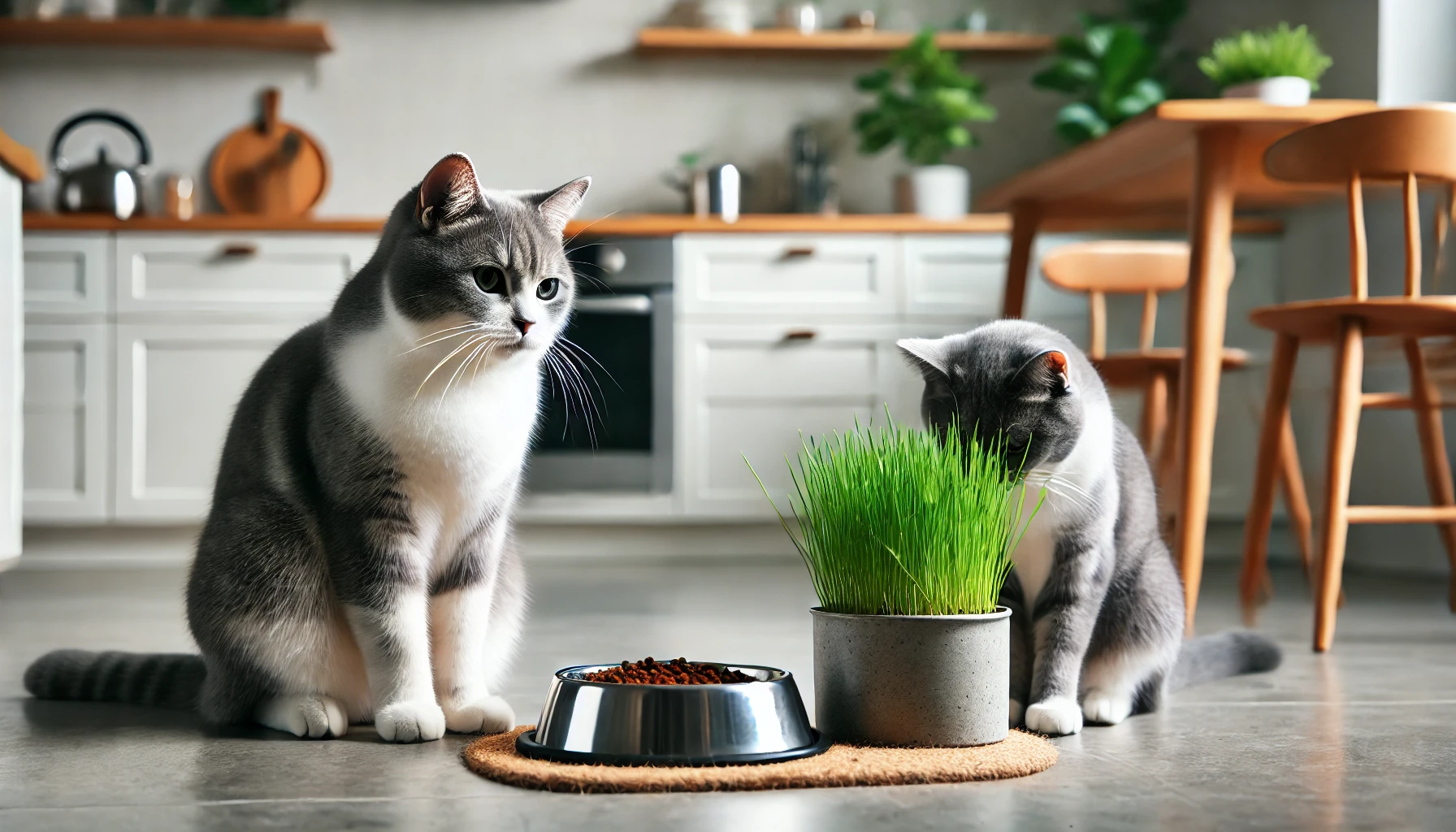
Nutritional Deficiencies
Cats often chew on plants because they may be lacking something in their diet.
While cats are obligate carnivores, meaning they primarily need meat, they might eat vegetation as a supplement.
This is often the case with fiber, which can help digestion.
If your cat is eating houseplants, it could be a sign that they need more variety or enrichment in their diet, which might divert their attention away from houseplants.
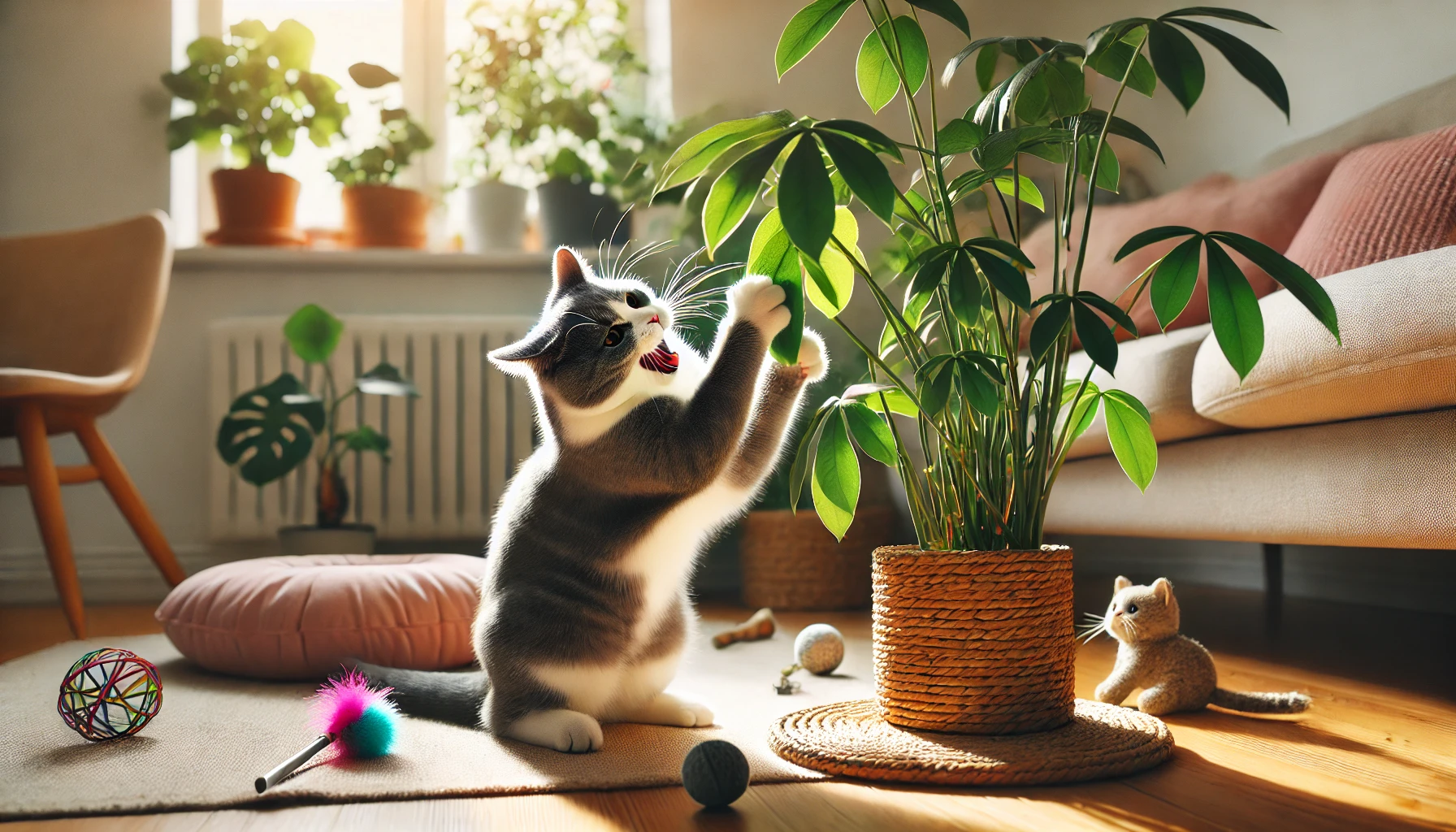
Boredom or Play
Sometimes, a mentally or physically under-stimulated cat will entertain themselves with houseplants.
The moving leaves simulate prey for them, and batting or nipping at the leaves might just be a fun game for your cat.
- Interactive toys provide a similar outlet for play and can shift the focus away from plants.
- Daily playtime with you helps your cat burn off extra energy.
- Rotating toys can keep things fresh and maintain your cat’s interest.
By understanding these root causes, you’ll have a clearer idea of why your cat is eating houseplants and can begin devising solutions tailored to their needs.
Knowing why your cat is drawn to houseplants is the first step toward preventing the behavior. Curiosity, boredom, and nutritional deficiencies are common reasons.

Creating a Non-Toxic Environment for Both Cats and Houseplants
In order to teach your cat to avoid eating houseplants, you need to create a safe environment for both your plants and your cat.
This includes setting limits and offering alternatives that will engage your feline and distract them from potentially toxic foliage.
How do you make sure both your cat and your houseplants stay safe?
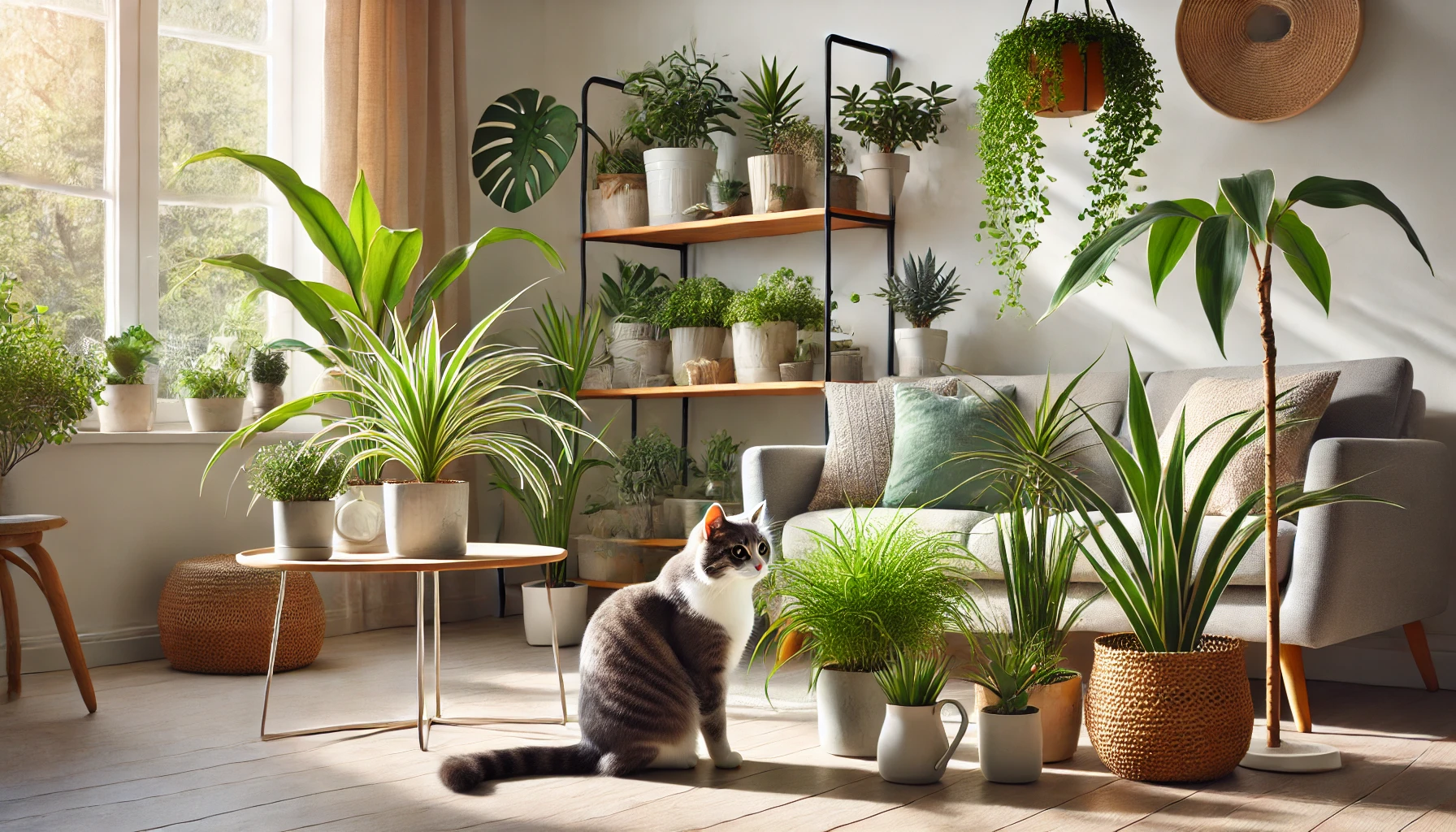
Choosing Non-Toxic Plants
First things first: choose houseplants that are non-toxic to cats.
Many common houseplants, such as lilies, philodendrons, and poinsettias, can be toxic if ingested by your cat.
Here are some safe alternatives:
- Spider plants – These plants will not harm your cat if they ingest any part of them. Plus, they’re resistant to a bit of chewing.
- Bamboo palms – These are resilient and non-toxic, making them a safe option for your feline friend.
- Boston ferns – Beautiful and non-toxic, these plants are great for cat owners.
- Cat grass – Planting a small patch of cat grass can satisfy your cat’s need for greens and offer a safe snack.
Knowing which plants are safe will not only protect your cat but also give you peace of mind in case they decide to nibble on your greenery.

Providing Cat-Friendly Alternatives
Redirecting your cat’s attention to alternatives is an effective way to stop them from eating houseplants.
The best approach is to offer cat-friendly plants for them to nibble on.
Catnip or cat grass, for example, can satisfy their urge and provide enrichment.
- Catnip – Many cats are naturally attracted to catnip, making it a great distraction from other houseplants.
- Cat grass – This easy-to-grow plant gives your cat the experience of nibbling on outdoor grasses, which they naturally enjoy.
- Cat toys – Providing your cat with a variety of stimulating toys helps reduce boredom, one of the main reasons cats might turn to houseplants for entertainment.
Providing these alternatives allows your cat to follow their natural instincts without turning your houseplants into snacks.
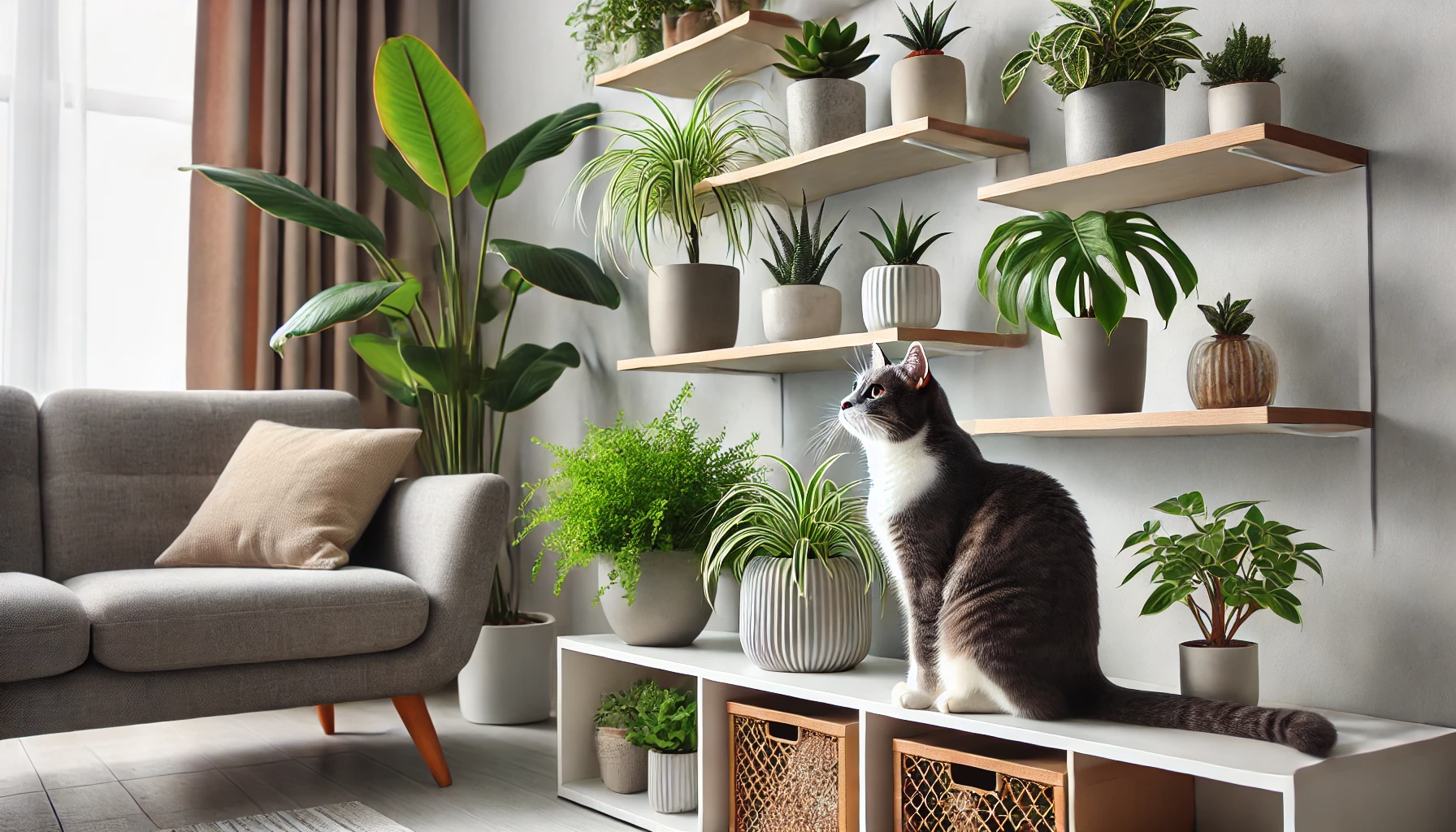
Using Plant Barriers
In addition to safe plants and alternatives, you may want to set up physical barriers to keep your cat away from houseplants.
Here are some effective strategies:
- Place plants out of reach – Suspend planters overhead or place them on high, inaccessible shelves.
- Use covered plant stands – Decorative plant covers or cages can protect your plants while still allowing them to beautify your home.
- Deter with sprays – Use natural deterrent sprays made from citrus or other cat-repelling ingredients to keep cats from chewing on the plants.
Setting up physical barriers reduces your cat’s chances of reaching plants and helps reinforce the idea that houseplants are off-limits.
Creating a safe space for both your cat and your plants is essential. Choose non-toxic plants and set up barriers to reduce temptation.
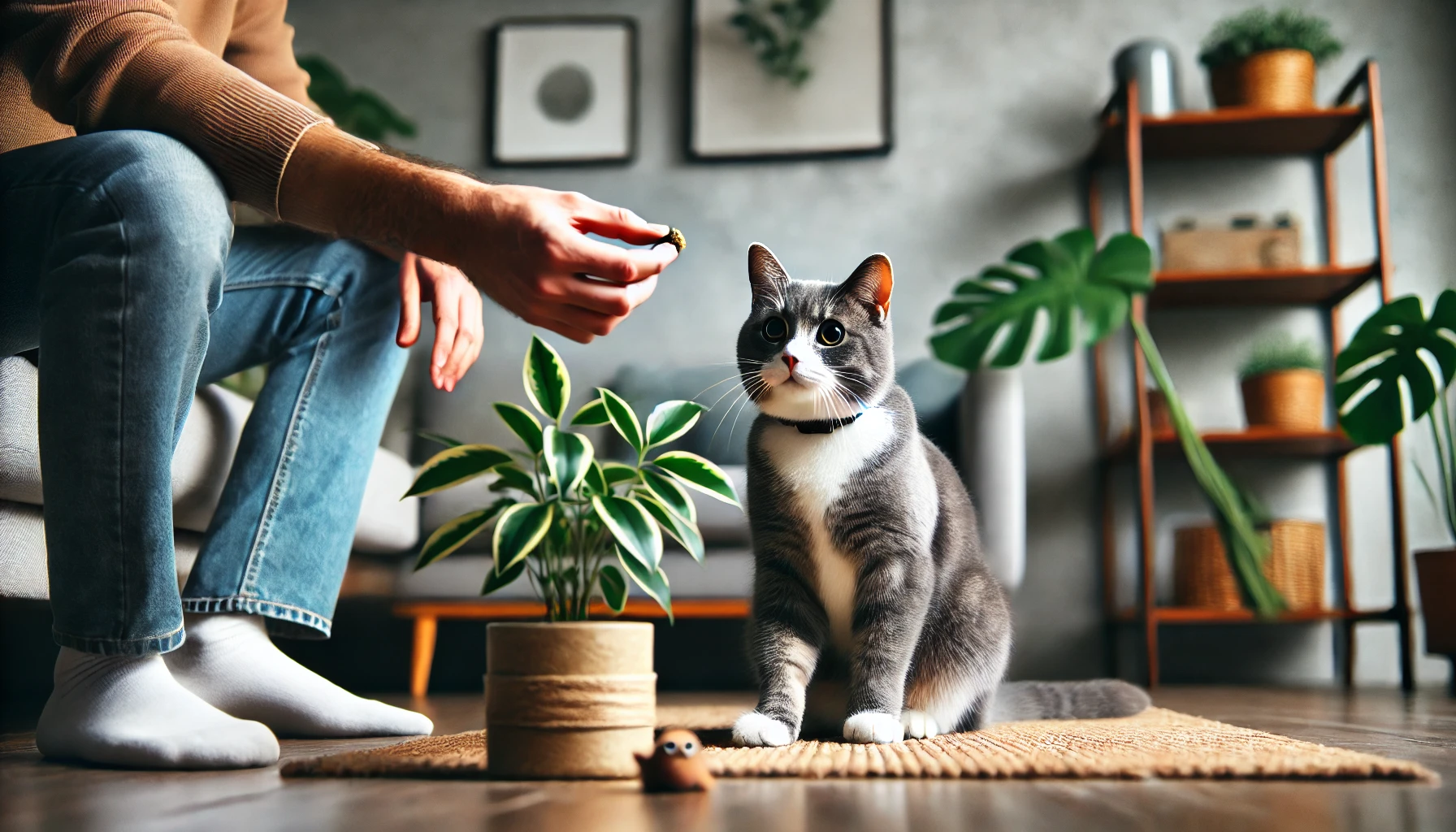
Training Methods for Discouraging Plant Eating
It takes time to train your cat to avoid eating houseplants.
Using positive reinforcement, deterrents, and distractions can effectively teach your cat to leave the plants alone.
Let’s explore the most effective methods to discourage plant eating.
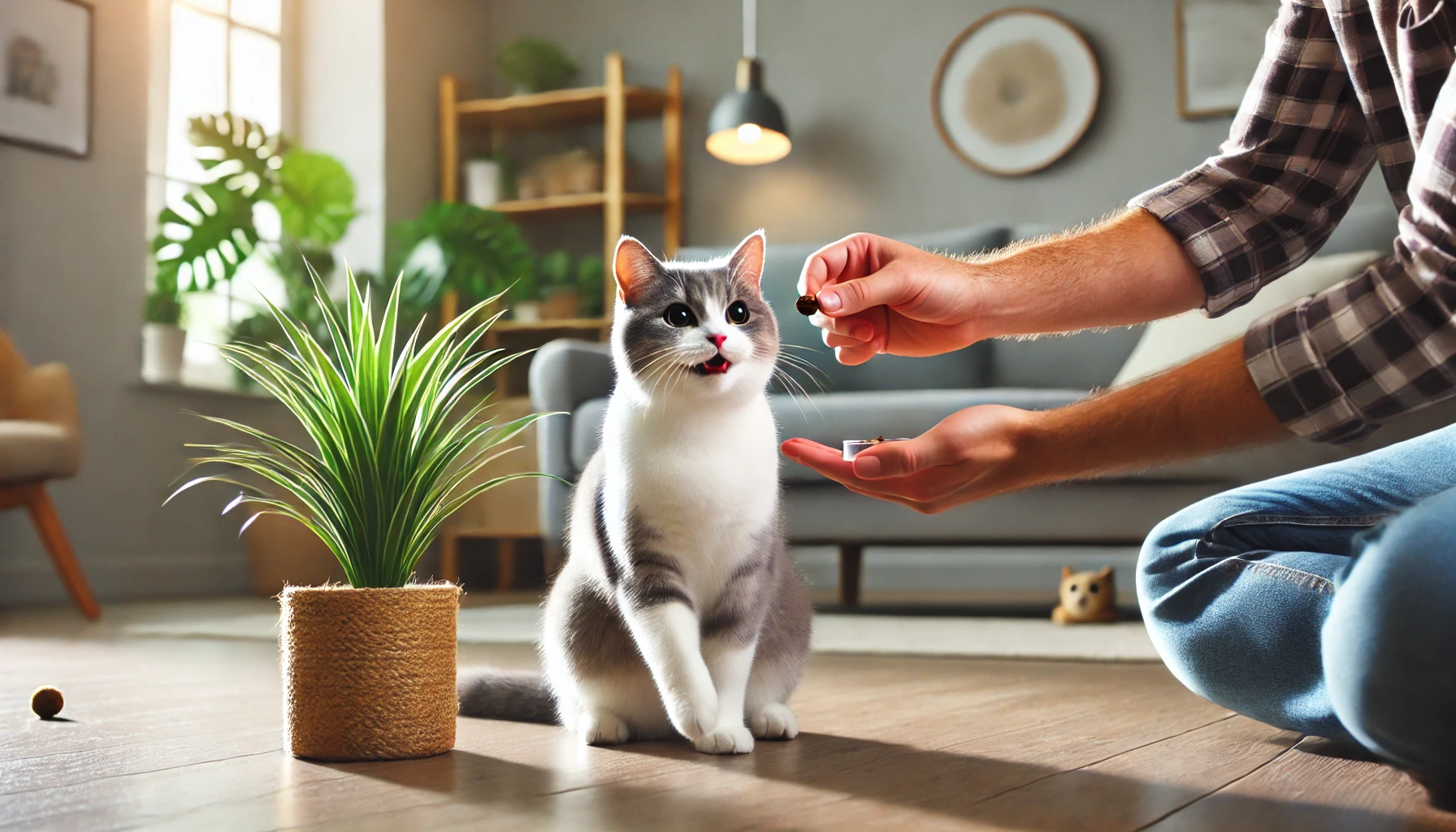
Positive Reinforcement Methods
One of the best ways to teach your cat to avoid eating houseplants is through positive reinforcement.
Rather than punishing your cat for bad behaviors, reward them when they exhibit good behaviors, such as ignoring the plants.
This strengthens the desired action.
- Use treats: Reward your cat whenever they avoid a plant or follow your command to leave the plants alone by giving them special treats.
- Praise and petting: Some cats love being praised verbally and fussed over when they behave well. This strengthens your bond and helps teach them good habits.
- Consistency: Consistency is key. Reward your cat every time they do the right thing, so they start associating leaving plants alone with positive outcomes.
With regular practice, positive reinforcement can help your cat learn to avoid eating houseplants.
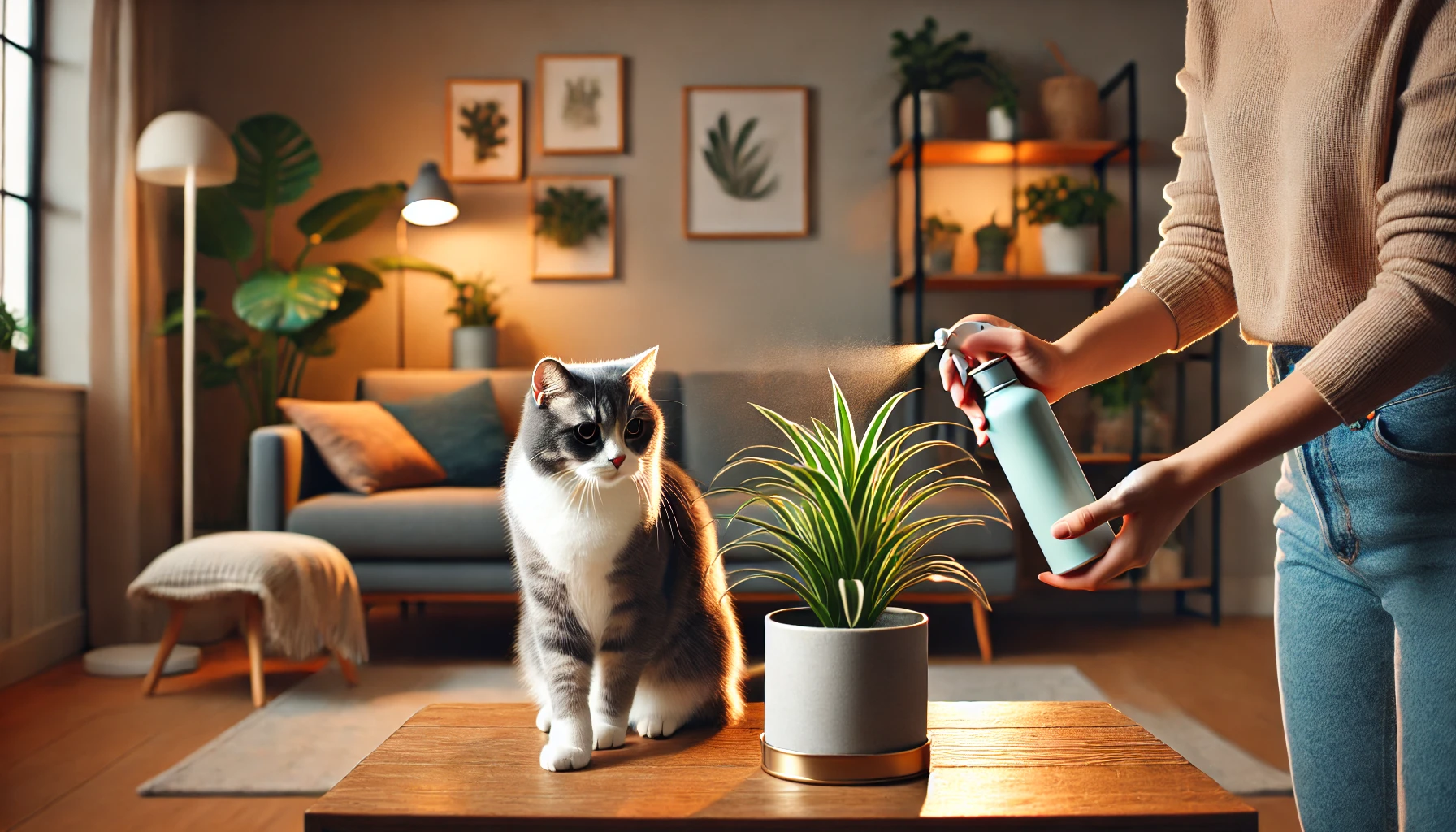
Deterrent Sprays
Another way to stop your cat from eating houseplants is by using deterrent sprays.
Cats naturally dislike certain smells, such as citrus and bitter flavors.
Spraying these on your plants can help keep your feline friend away.
- Citrus sprays: Many deterrent sprays are made from citrus oils, which cats typically dislike. Spraying these on the leaves and stems of your plants can deter your cat from chewing on them.
- Bitter apple spray: This non-toxic spray has a taste that is unpleasant to cats but safe for plants, making it a valuable tool in your training efforts.
- Homemade vinegar spray: A simple solution of vinegar and water can also act as a deterrent. Test a small part of the plant first to ensure it won’t cause damage.
Deterrent sprays are a great addition to your training routine, especially if your cat is stubborn about nibbling on houseplants.

Redirecting Attention with Toys
If your cat chews plants out of boredom, providing stimulating toys can help redirect their attention.
Cats that are mentally and physically engaged are less likely to develop destructive behaviors like eating houseplants.
- Interactive toys: Toys that move or make sounds can capture your cat’s attention, satisfying their hunting instincts and reducing their interest in plants.
- Puzzle feeders: These toys challenge your cat to work for their food, keeping them busy and mentally stimulated.
- Feather toys: Toys with feathers simulate the movement of prey, offering your cat a fun and safe way to engage their instincts.
By keeping your cat engaged with toys, you can prevent them from becoming bored and turning to your plants for entertainment.
Positive reinforcement and deterrent methods can effectively train your cat to avoid houseplants over time.
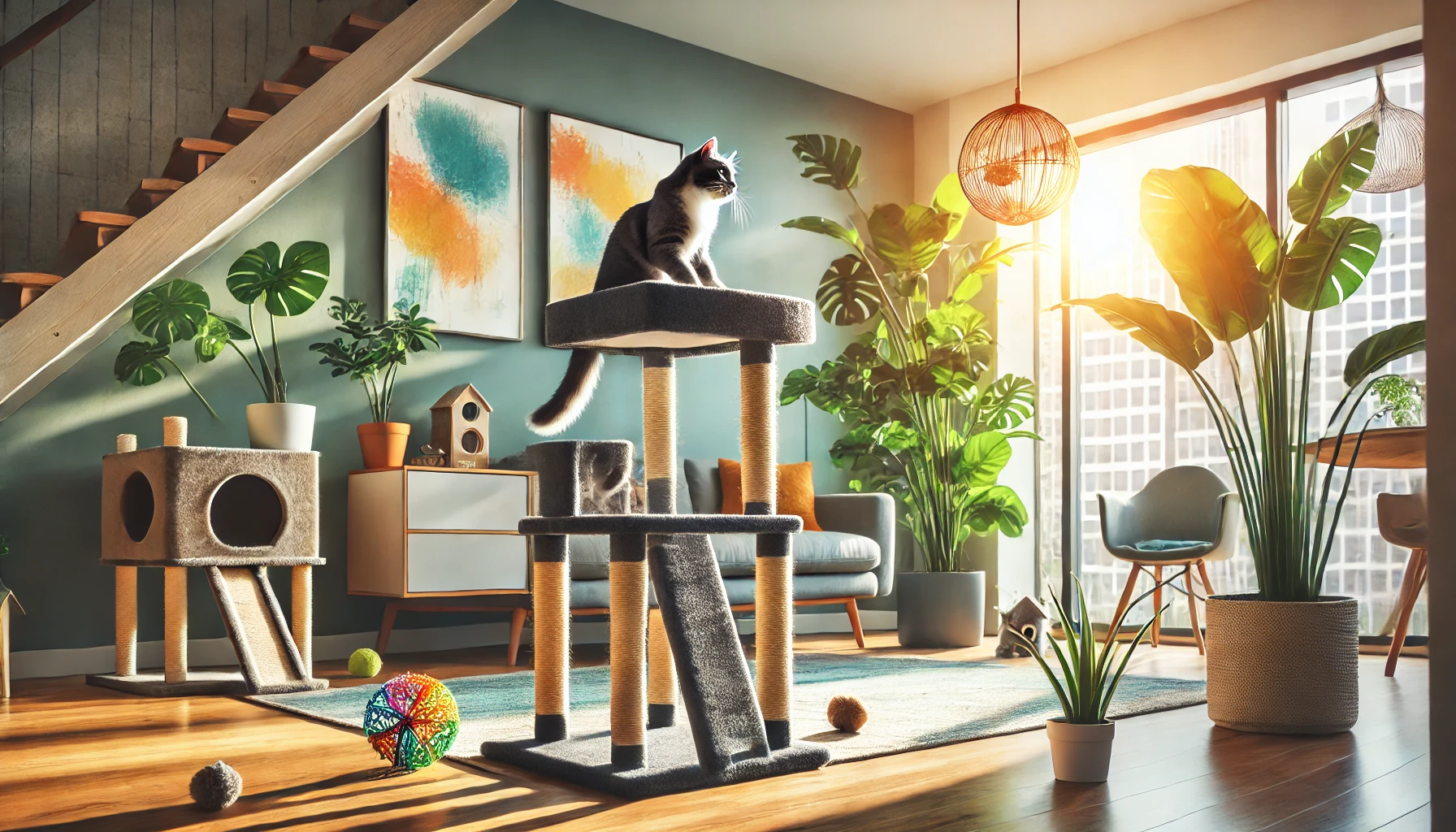
Engage Your Cats in Healthy Activities to Avoid Eating Houseplants
One effective way to ensure your cat does not eat houseplants is by keeping them occupied with healthy and stimulating activities.
Often, cats resort to eating plants due to boredom or a lack of mental and physical stimulation.
By providing outlets for their energy and curiosity, you can significantly reduce their interest in your greenery.
Let’s explore how to entertain your cat and distract them from houseplants.
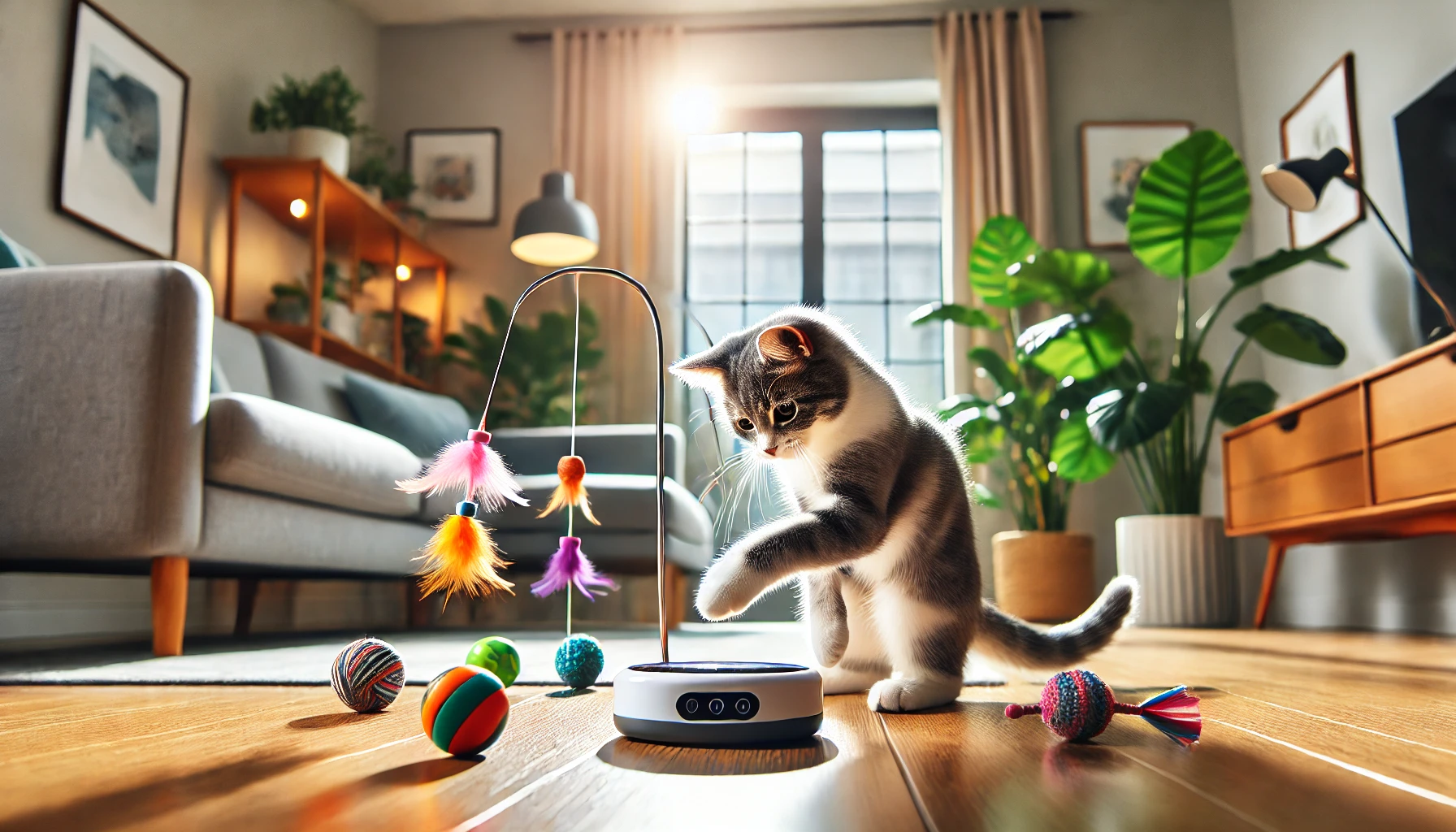
Stimulating Toys
One of the best ways to keep your cat active is by using interactive and stimulating toys.
These toys can mimic natural hunting behaviors, while also providing physical and mental challenges that many indoor cats need.
Here are some examples:
- Laser pointers: Cats enjoy chasing laser pointers and can stay active for long periods. However, be cautious not to overuse them, as some cats may get frustrated if they can never ‘catch’ the prey.
- Electronic motion toys: These toys simulate the movement of small animals, engaging your cat’s hunting instincts and reducing their interest in houseplants.
- Cat tunnels: Tunnels provide a place for cats to hide and play. They satisfy a cat’s natural curiosity and instinct for exploration, keeping them occupied and away from plants.
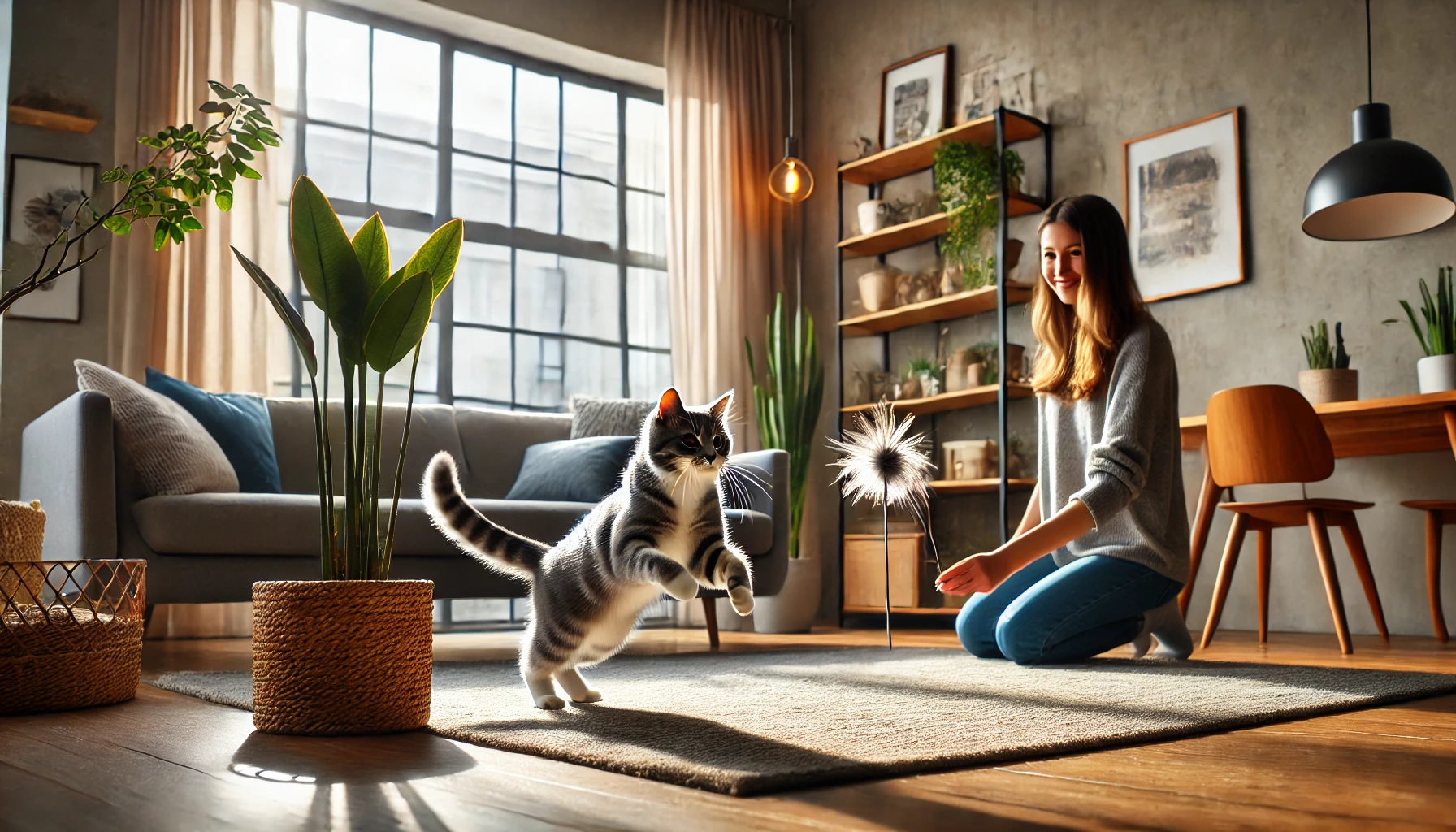
Interactive Playtime with Your Cat
One of the best ways to ensure your cat gets enough mental and physical exercise is by dedicating time to interactive play sessions.
Regular playtime helps prevent destructive behaviors, such as eating houseplants.
- Daily play sessions: Play with your cat daily using toys, feather wands, or even simple games like fetch. This strengthens your bond and helps manage your cat’s energy levels.
- Rotating toys: Keep your cat interested by rotating their toys regularly. Introducing new toys or hiding old ones to be rediscovered can keep your cat mentally stimulated.
- Puzzle feeders: Turn mealtime into a fun challenge by using puzzle feeders. These toys keep your cat busy and happy, as they work to get their food out.
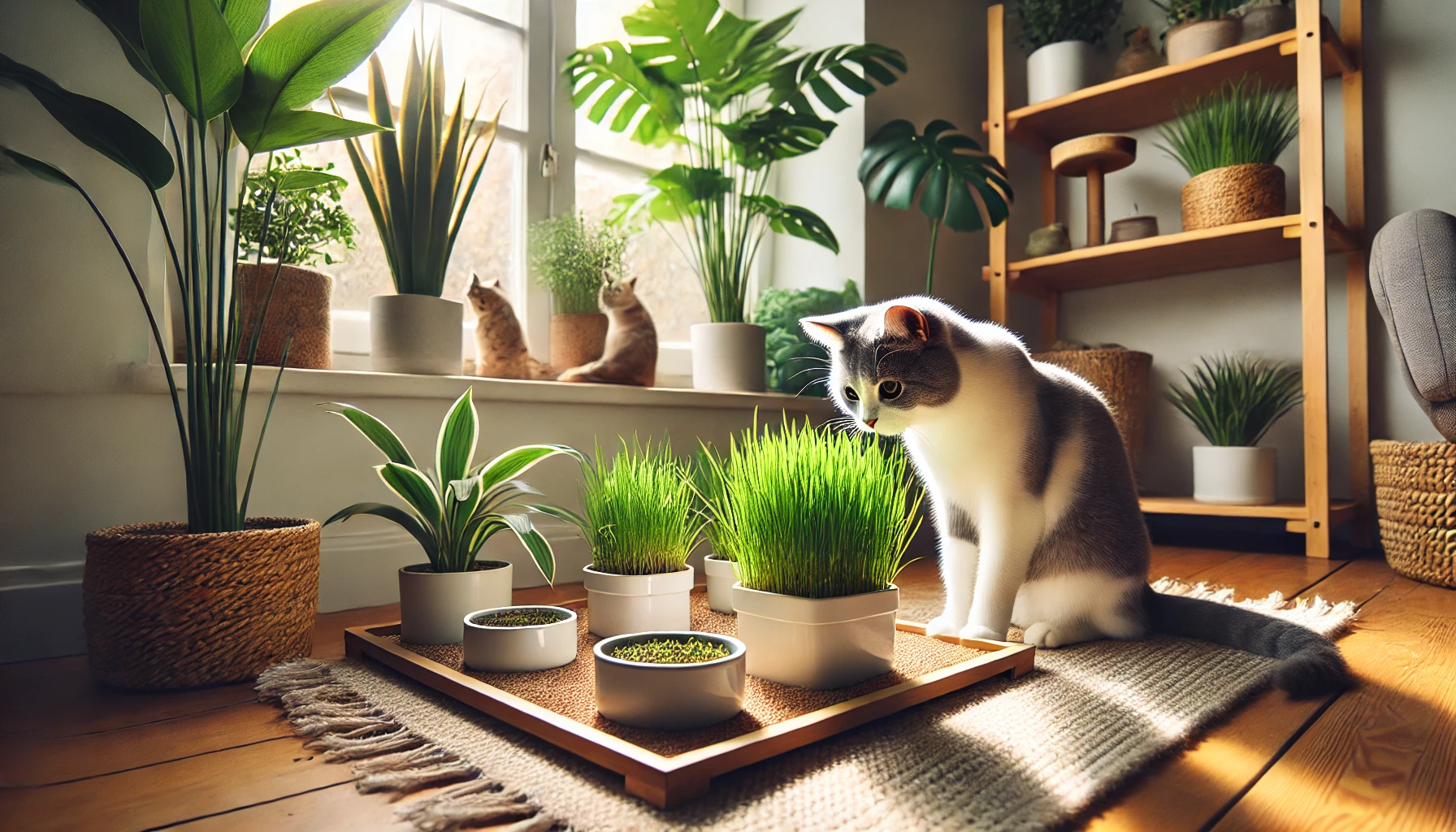
Setting Up a Cat Grass Station
Another way to divert your cat’s attention from houseplants is by giving them their own ‘garden.’ Setting up a small station with cat grass or other safe plants provides your cat with a healthy and satisfying alternative to your more delicate houseplants.
- Cat grass: Easy to grow indoors, cat grass is safe for cats to chew on. It satisfies their craving for greens without endangering your houseplants.
- Catnip plants: Growing catnip or other cat-friendly herbs offers another outlet for your cat’s plant-eating habits, while also providing stimulation and enrichment.
- Designated plant area: Set up a specific area for your cat with safe plants. This way, they’ll learn which plants are theirs and will be less likely to nibble on your other houseplants.
By engaging your cat in these healthy activities, you can reduce their focus on eating houseplants.
Keeping your cat occupied with much-needed physical and mental stimulation is key to protecting your plants from unwanted chewing.
Keeping your cat entertained with toys and interactive activities helps them avoid boredom-driven plant eating.
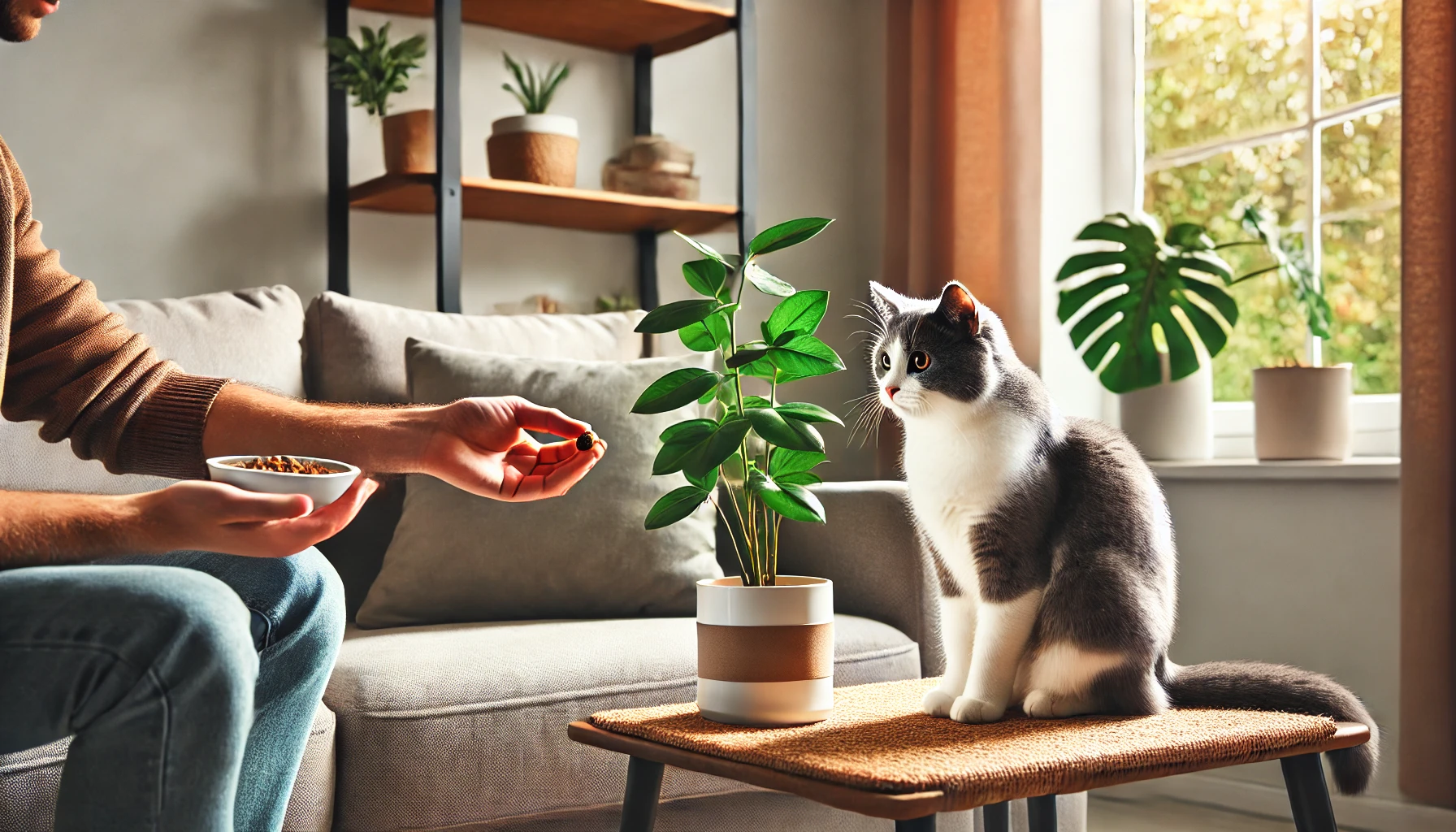
Long-Term Measures: Ensuring Consistency in Training
Training a cat to stop eating houseplants takes time and patience, but long-term remedies will help maintain the progress you’ve made.
Consistency is key when keeping your cat’s behavior in check, and establishing a routine can help reinforce their good habits.
Let’s explore how you can ensure consistency in training and keep your cat from eating houseplants in the future.
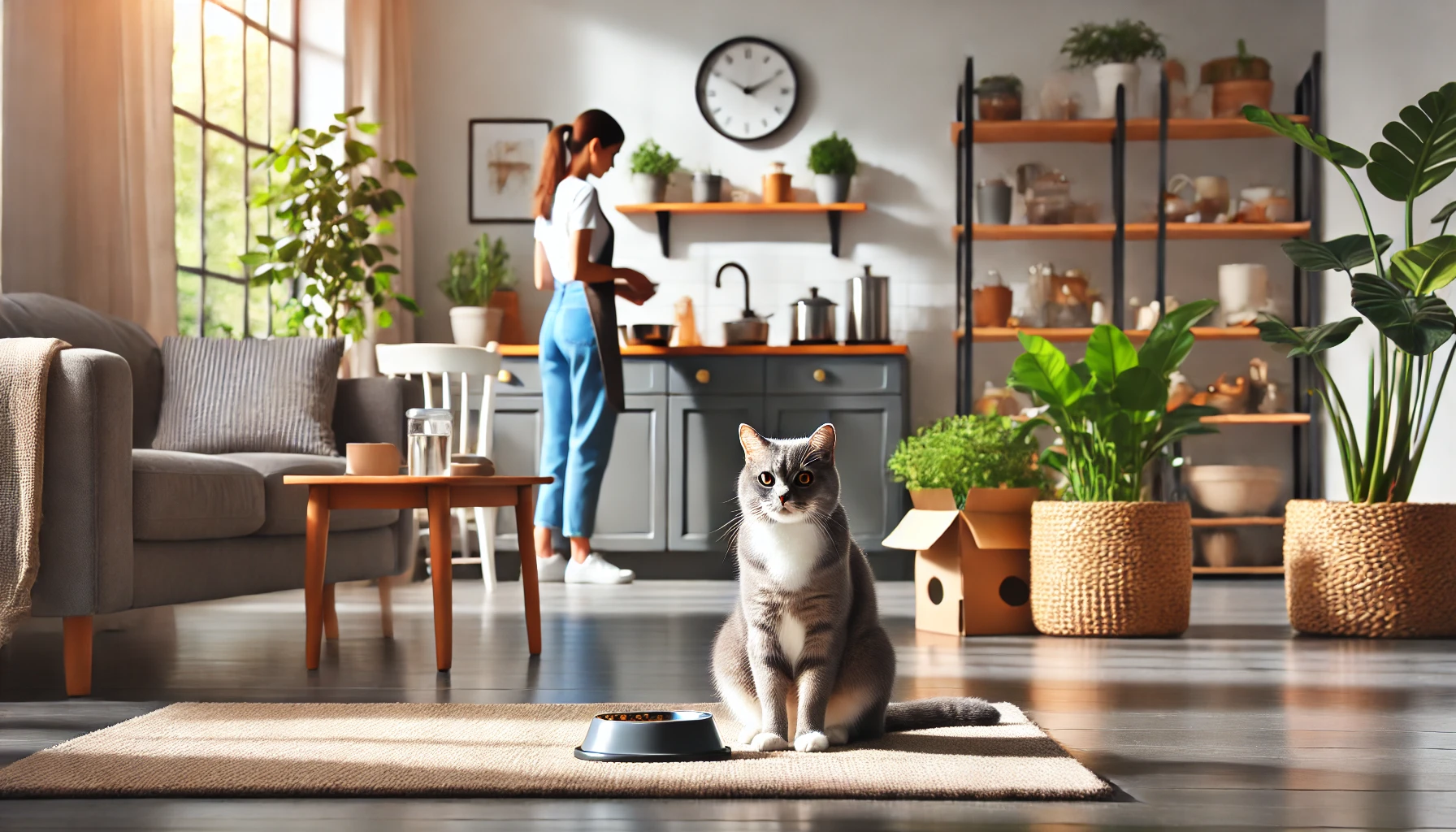
Establish a Routine
Cats are creatures of routine.
Establishing a regular pattern of feeding, playtime, and interaction will keep them engaged and reduce the likelihood of boredom or destructive behavior.
- Establish playtimes: Regular play sessions at the same time each day teach your cat when to expect attention, minimizing the urge to bother houseplants for entertainment.
- Scheduled meals: Feeding your cat at regular intervals throughout the day keeps them full and lowers their curiosity about plants. A well-fed, happy cat is less likely to nibble on plants.
- Consistency in training: Reinforce positive behavior or apply deterrents each time your cat approaches houseplants. This helps them understand that their actions will always be met with a consistent response.
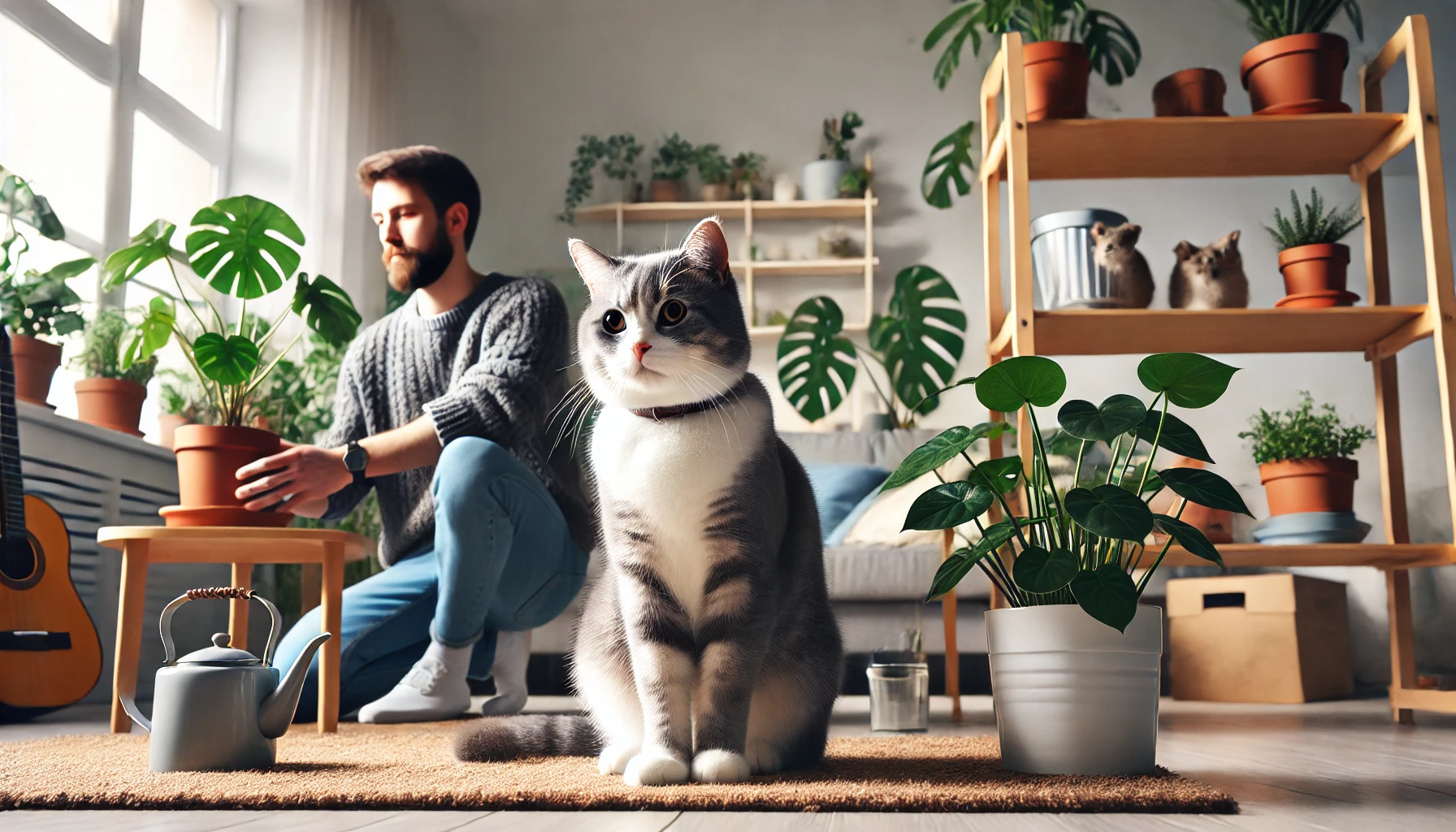
Monitoring and Adjusting Techniques
Even after your cat learns to avoid houseplants, it’s important to monitor their behavior.
Cats may regress or develop new habits over time, meaning you’ll need to adjust your techniques as needed.
- Observe changes in behavior: If your cat starts showing interest in plants again, reintroduce deterrent sprays or spend more time engaging them in play to refocus their energy.
- Adjust routines as necessary: As your cat grows and their environment changes, their needs may shift. Be flexible with your training methods, adjusting them to match your cat’s behavior.
- Be proactive: Keep an eye on your plants and your cat’s behavior. Catching signs of a relapse early will make it easier to correct the issue.
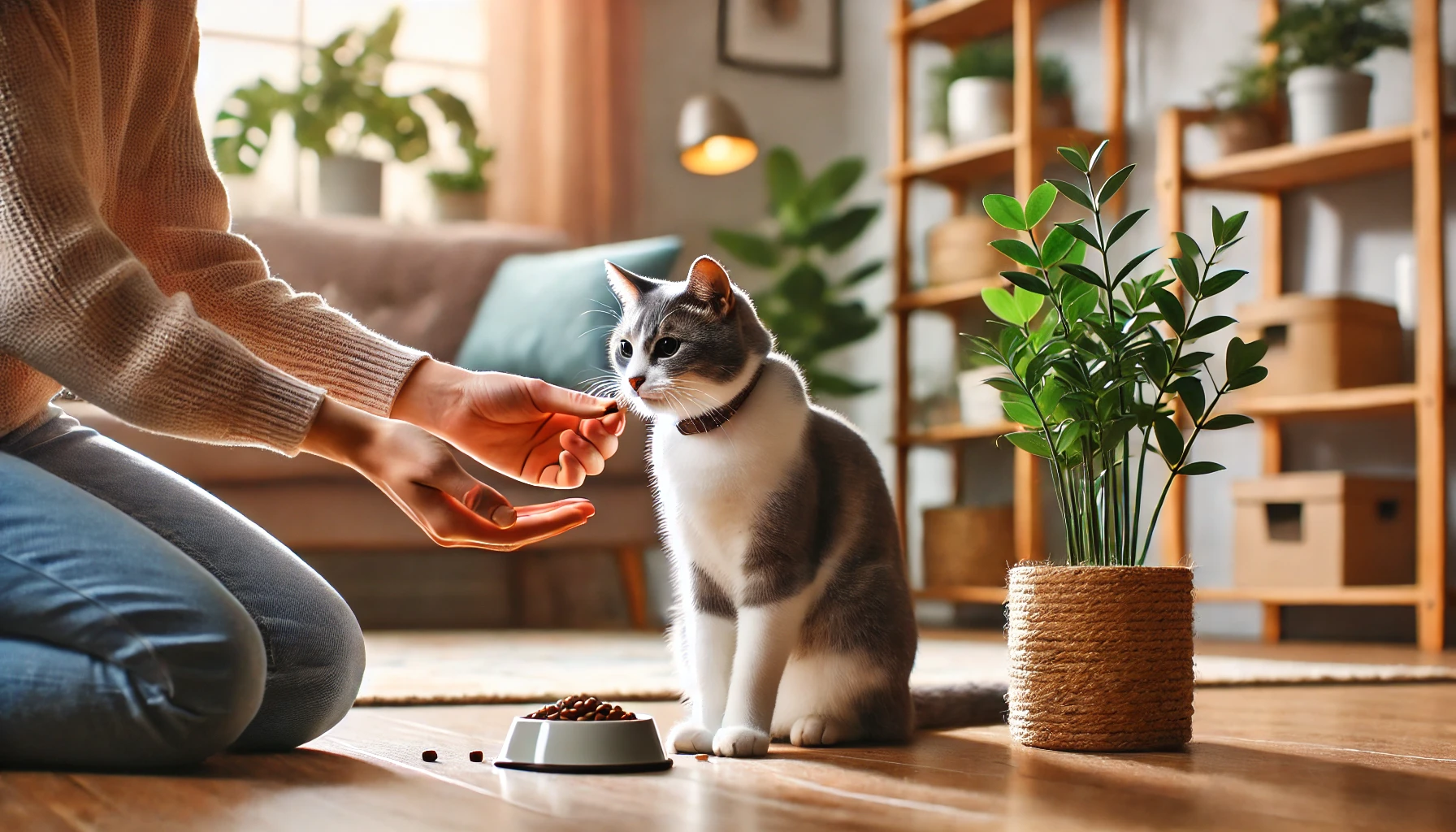
Rewarding Good Behavior
For long-term success, it’s essential to continue rewarding your cat for good behavior.
Positive reinforcement will ensure that your cat associates avoiding houseplants with positive outcomes.
- Continue using treats: Whenever your cat avoids a plant or follows your command to stay away, reward them with a treat or praise. This encourages them to maintain good behavior.
- Verbal praise: Cats love verbal praise and affection. Continue recognizing their good behavior, and over time, they will associate avoiding plants with positive attention.
- Gradually reduce rewards: Once your cat consistently avoids houseplants, you can start phasing out treats and praise. However, occasional reinforcement will help maintain the behavior over time.
By maintaining consistency in your training efforts, monitoring your cat’s progress, and rewarding positive behavior, you’ll be able to ensure long-term success in preventing your cat from eating houseplants.
Patience and steady adjustments will keep your cat engaged and well-behaved for years to come.
Consistency is key in maintaining good behavior. Keep rewarding positive actions and monitor your cat’s progress over time.

Summary: Teaching Cats to Avoid Eating Houseplants Successfully
The process of training your cat to avoid eating houseplants requires thought and patience, but the results are well worth the effort.
By understanding why cats behave the way they do and applying targeted strategies, you can protect both your feline friend and your houseplants.
Let’s review the main steps you can take to ensure your cat leaves houseplants alone while staying happy and healthy.
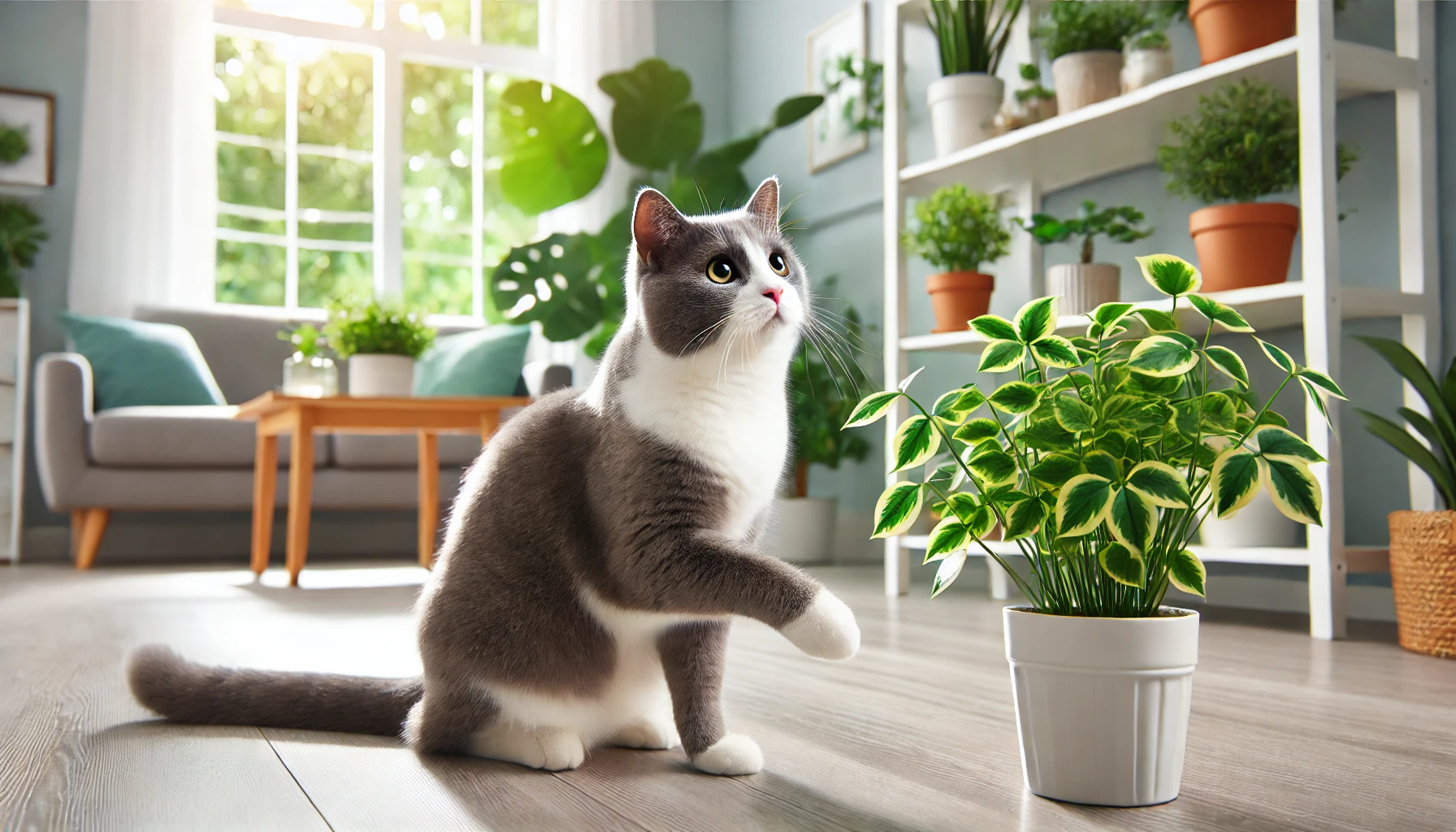
Knowing Why Cats Eat Houseplants
Cats are naturally curious, and their interest in houseplants may come from boredom, nutritional deficiencies, or an instinctive urge to chew.
Once you understand the reasons behind this behavior, you can better manage and redirect it.
Whether it’s due to curiosity or a lack of nutrients, understanding why your cat eats plants is the first step in addressing the issue.
Providing non-toxic alternatives and a more enriching environment can help curb harmful behaviors.
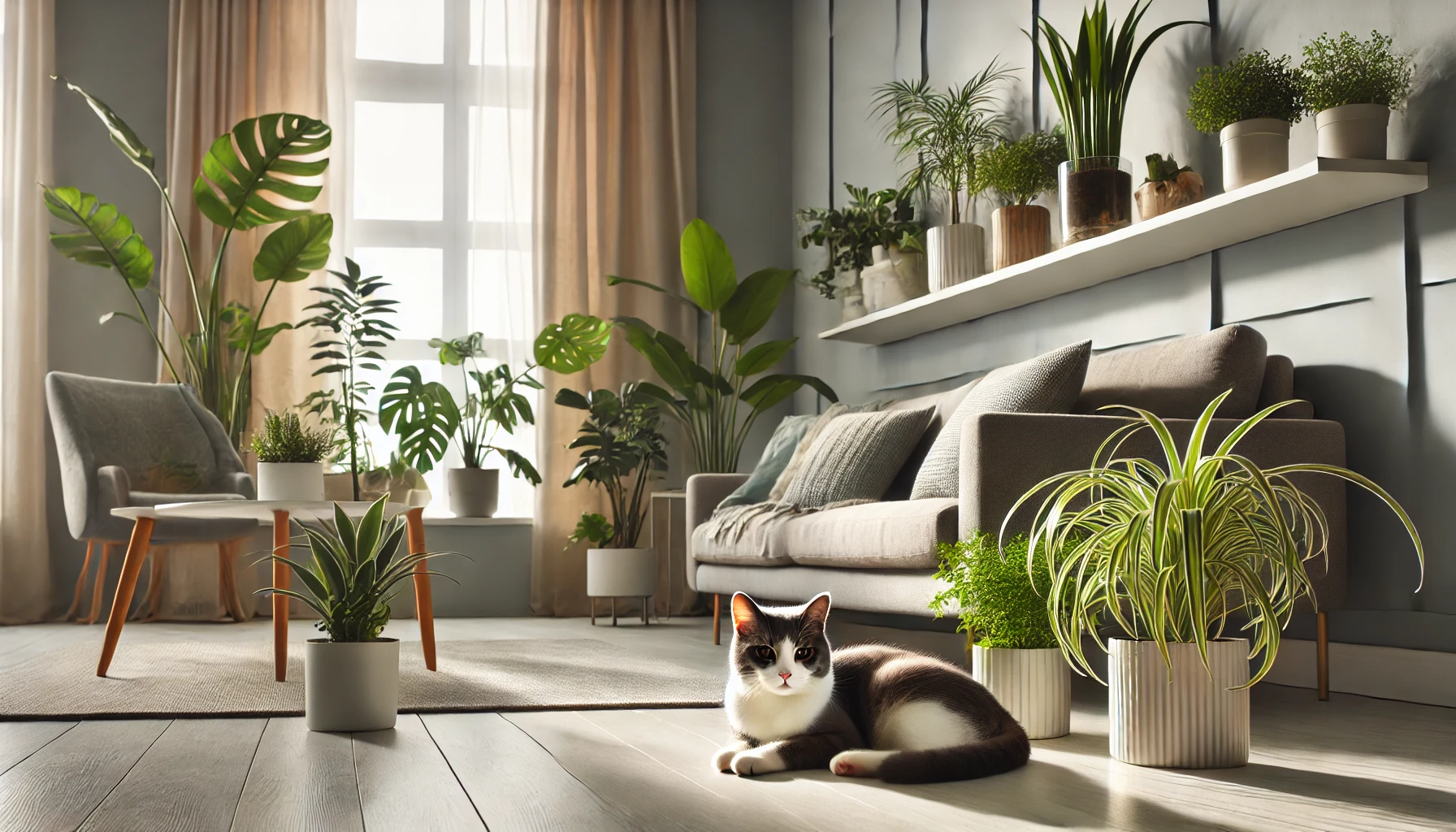
Creating a Safe Environment for Cats and Plants
A key solution is to reduce your cat’s temptation to eat houseplants.
Choosing non-toxic plants that won’t harm your cat if ingested and setting up barriers to keep plants out of reach are essential steps.
Providing alternatives like catnip and cat grass ensures your cat’s needs are met without turning to your valuable greenery.
It’s crucial to be aware of toxic plant types in your home and take extra precautions with barriers and deterrents to ensure both your plants and your cat are safe.
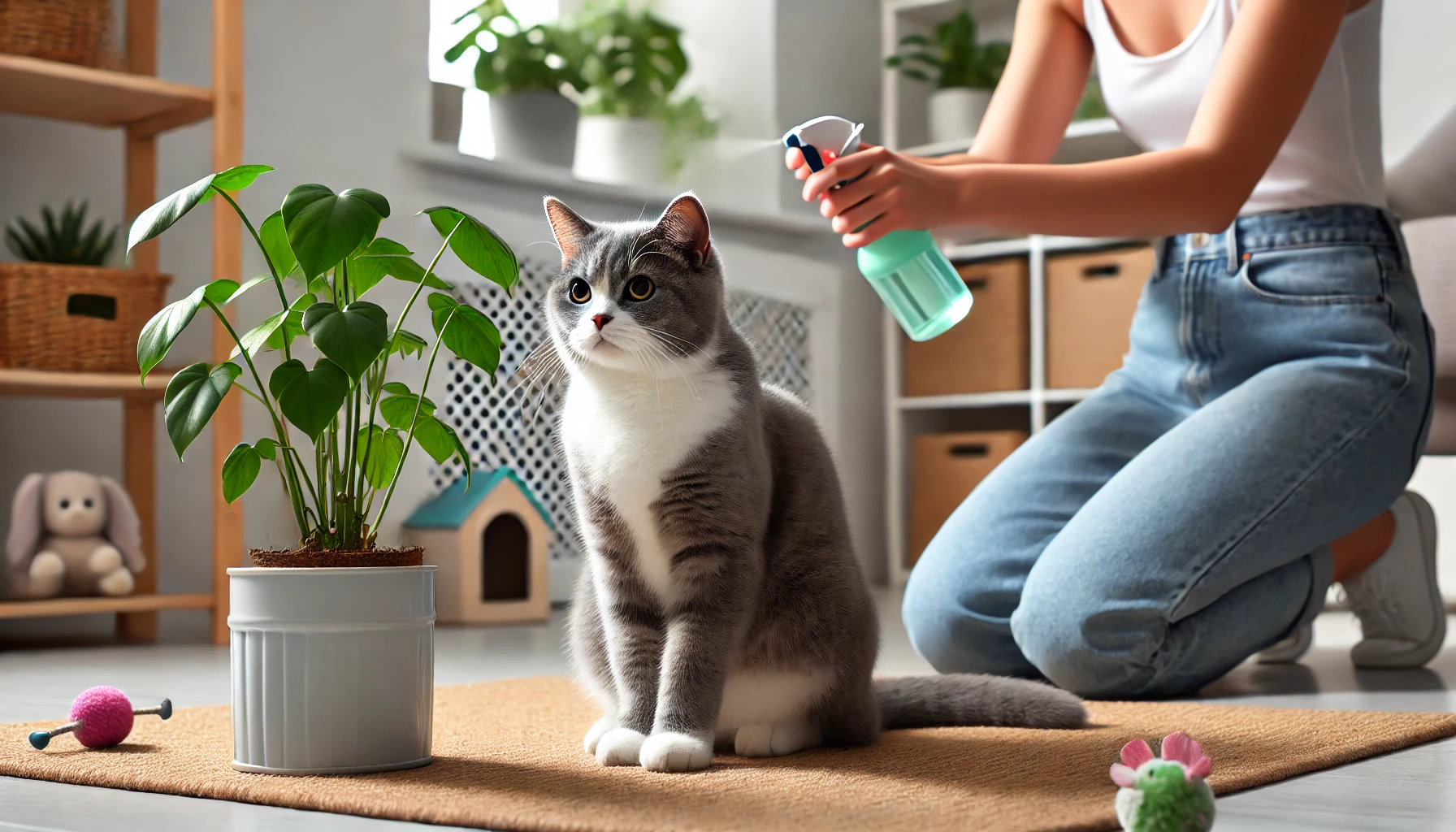
Training Techniques That Deter Plant Eating
Consistency is vital when training your cat to avoid houseplants.
Positive reinforcement—such as rewarding with treats and praise for good behavior—helps your cat associate avoiding plants with positive outcomes.
Deterrent sprays and redirecting your cat’s attention to toys also prevent the development of plant-chewing habits.
By combining positive reinforcement with deterring measures, you can gradually adjust your cat’s behavior over time.
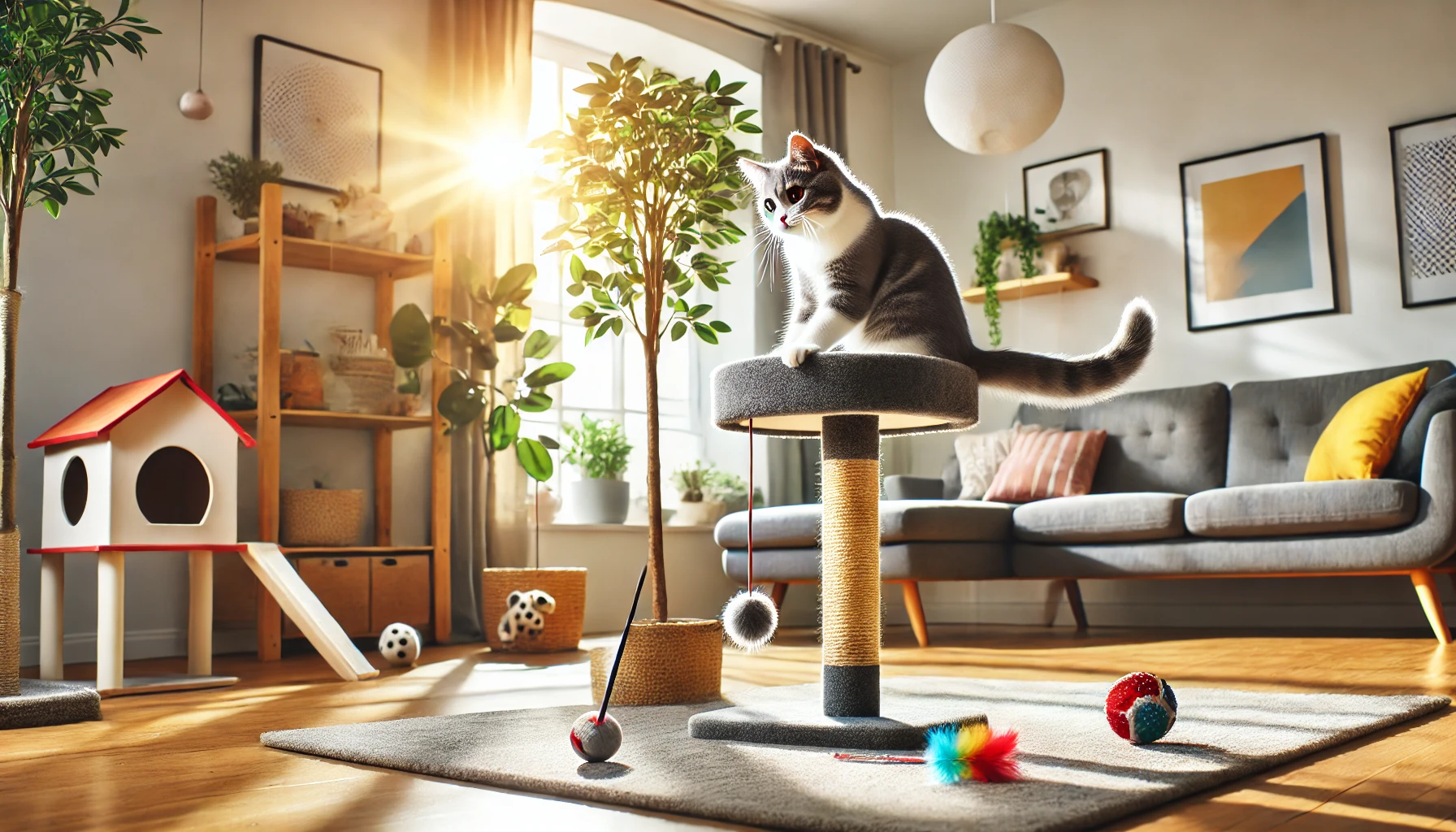
Keeping Cats Engaged with Healthy Activities
Interactive play sessions, stimulating toys, and designated cat-safe plant areas can help redirect your cat’s energy and curiosity away from houseplants.
Keeping your cat physically and mentally engaged reduces boredom and prevents destructive behaviors like plant chewing.
Providing healthy activities, along with proper redirection, ensures your cat has plenty of outlets to stay entertained without targeting your plants.
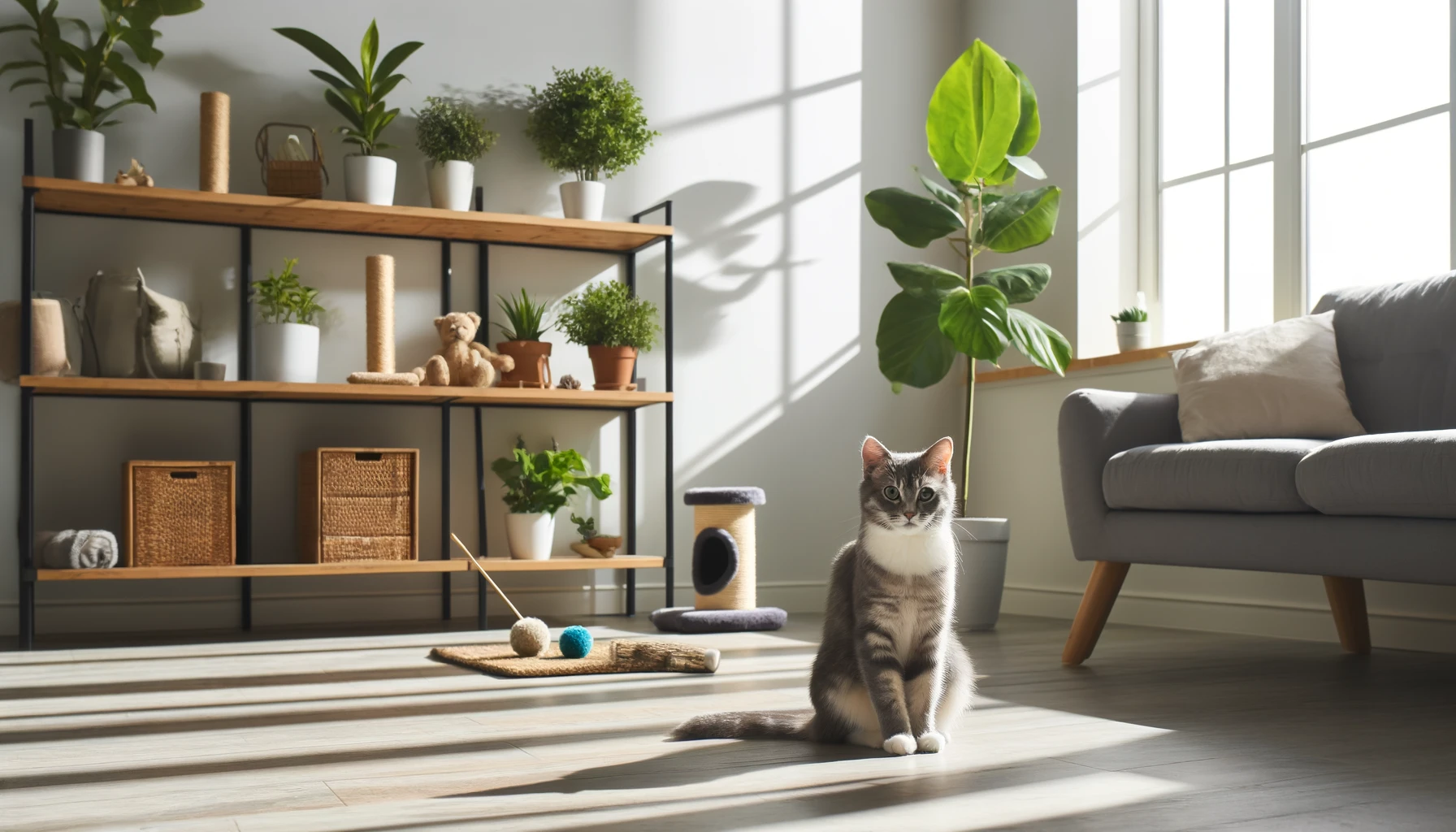
Long-Term Fixes for Success
In the long run, consistency and monitoring are crucial for maintaining the progress you’ve made.
Stick to a routine, adjust training methods as needed, and continue to reward your cat for good behavior.
Over time, your cat will associate staying away from plants with positive outcomes, leading to long-lasting success.
It’s important to observe your cat’s behavior over time, make adjustments when necessary, and persist with the good habits they’ve learned through consistent effort.
By combining understanding, safe alternatives, consistent training, and healthy engagement, you can successfully teach your cat to avoid eating houseplants.
With patience and gradual steps, your cat will develop lasting good behaviors that keep both them and your plants safe.
By understanding your cat’s needs and providing safe alternatives, you can effectively teach them to avoid houseplants for good.
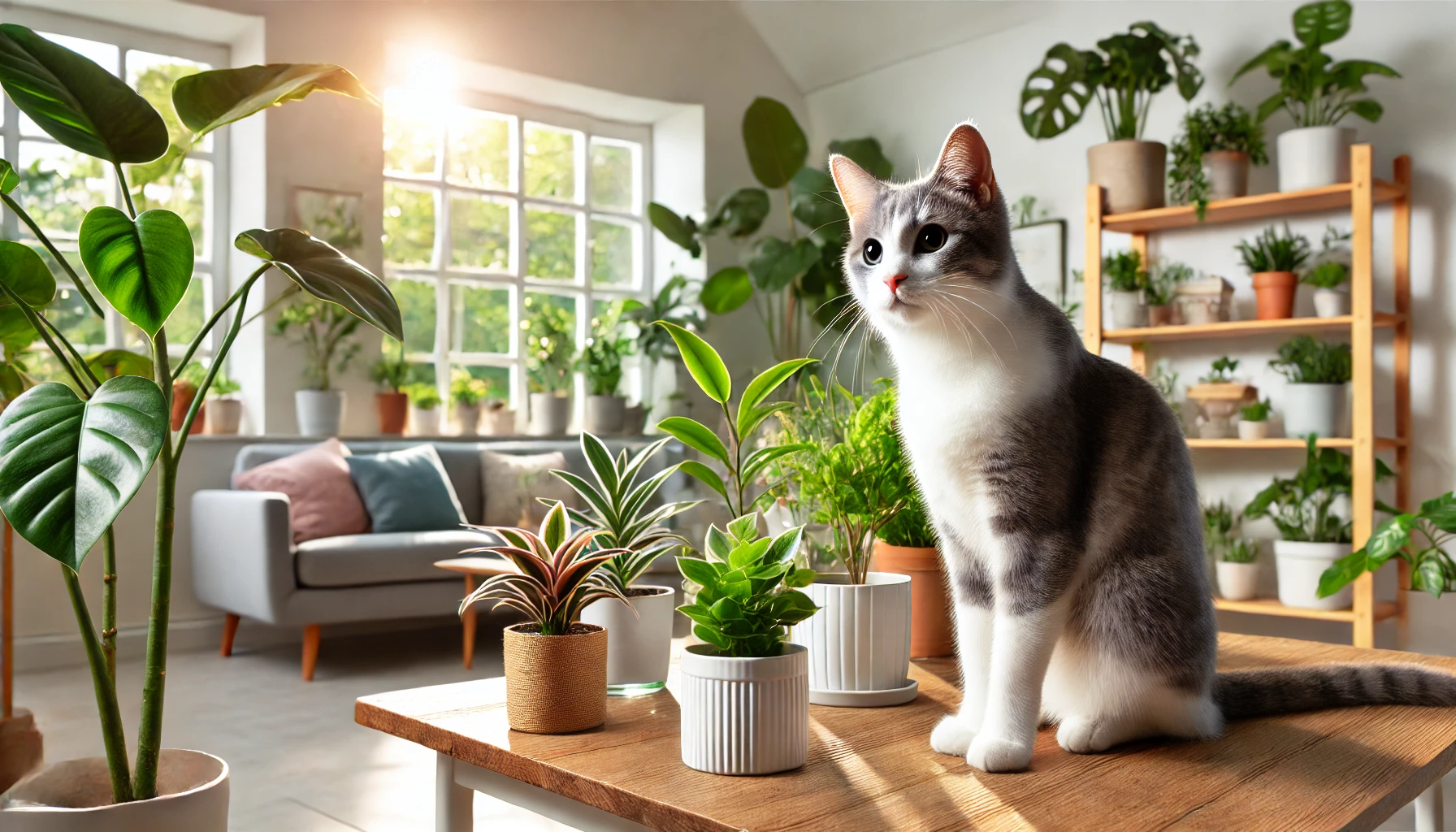
Cats and Eating Houseplants: Frequently Asked Questions
Here are some of the most frequently asked questions about teaching your cat to avoid eating houseplants.
These answers will guide you as you manage your cat’s behavior and ensure their safety around houseplants.
Why do cats eat houseplants?
Cats may eat houseplants due to curiosity, boredom, or nutritional deficiencies.
It is instinctive—cats in nature chew on grass and other plants to aid digestion and for enrichment.
How can I prevent my cat from eating houseplants?
Use positive reinforcement to reward your cat for avoiding plants, provide alternatives like cat grass, and apply deterrent sprays on houseplants.
Engage your cat with toys to divert their attention and prevent boredom-driven plant eating.
Which plants are non-toxic to cats?
Spider plants, bamboo palms, Boston ferns, and cat grass are non-toxic and safe for cats.
Always check new plants to ensure they are safe if ingested by your cat.
Can houseplants make my cat sick?
Yes, toxic houseplants like lilies, philodendrons, and poinsettias can cause vomiting, drooling, or worse if ingested by your cat.
Ensure all plants in your home are safe for cats to prevent illness.
Is cat grass a good substitute for houseplants?
Yes, cat grass satisfies your cat’s craving for greens and provides a safe, non-toxic alternative to chew on.
It helps reduce their interest in potentially harmful houseplants.
How often do I need to reward my cat during training?
During training, reward your cat every time they avoid a plant or follow your command to leave it alone.
This consistency reinforces positive behavior and helps them avoid houseplants.
Are deterrent sprays safe for houseplants?
Yes, most cat-deterrent sprays are non-toxic and safe for houseplants.
These sprays typically contain ingredients like citrus oils, which cats dislike, without harming the plants.
What toys can help distract my cat from houseplants?
Interactive toys like laser pointers, electronic motion toys, and feather wands engage your cat’s hunting instincts.
These toys can keep your cat mentally stimulated and reduce their interest in houseplants.
Can I train my cat to avoid all plants?
Yes, you can train your cat to avoid all plants with consistent training.
Using positive reinforcement, offering alternatives, and setting up deterrents can help break the plant-eating habit over time.


